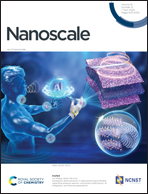The existence of a strongly bonded layer in associating liquids within silica pores – a spectral and molecular dynamics study†
Abstract
The properties of confined materials are assumed to be governed by the phenomena occurring at the interface, especially the formation of an irreversible adsorption layer (IAL), which has been widely discussed and detected in the case of thin polymer films and silica nanoparticles. In this paper, we present a novel experimental approach allowing us to reveal the formation of an IAL in two phenyl alcohols infiltrated into various mesoporous silica templates. The proposed methodology (based on evaporation) allowed us to detect the alterations in the OH and aromatic CH stretching vibration bands in infrared spectra, which were considered as evidence of the existence of IAL in constrained systems. Such interpretation was also confirmed by complementary molecular dynamics (MD) simulations that indicated the creation of much stronger hydrogen bonds between alcohols and silanol units than between alcohols themselves. Moreover, computation allowed us to identify additional enormously strong π-stacking interactions between phenyl rings stabilizing the interfacial layer. MD simulations also shed new light on the clustering process of both alcohols under confinement. Simulation and experimental data presented in this paper allowed a much deeper understanding of the processes occurring at the interface-formation of IAL and the association phenomenon at the nanoscale level.



 Please wait while we load your content...
Please wait while we load your content...